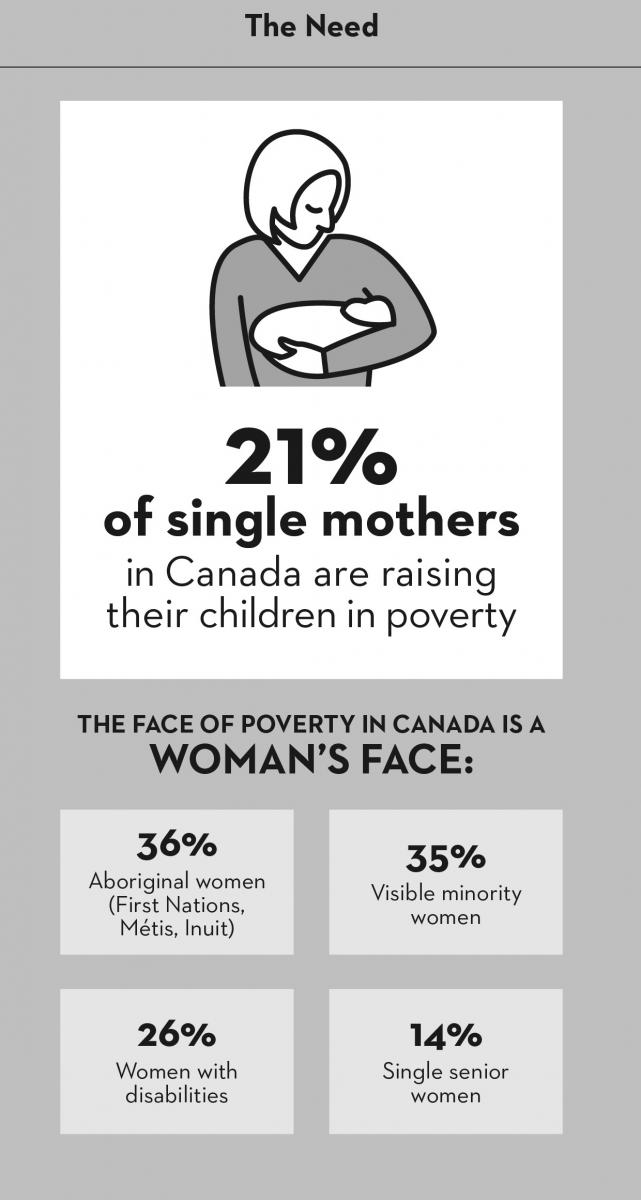Gender, race, and social status are all factors that play a critical role in determining who is poor. Across Canada, women are more likely to live in conditions of poverty than men. The below infographic, produced by the Canadian Women's Foundation, displays some startling facts about the high rate of poverty among women.
Single mothers
The infographic states that 21% of single mothers in Canada live in poverty. There are many factors that come together to create a situation where over 1 in 5 mothers are living in poverty. Women spend more time than men doing unpaid work; this includes childcare, meal preparation, and housework. The lack of affordable childcare in Canada also forces mothers to limit their career and education opportunities. In order to balance their work and home responsibilities, many women have no choice but to choose employment that is precarious: positions that are part-time, seasonal, or operate on a contractual basis. The gender wage gap is another factor that contributes to increased rates of poverty among women rather than men. Jobs traditionally occupied by women pay less than jobs traditionally occupied by men.
Investing in the lives of women is tantamount to investing in the lives of children. Children growing up in poverty are far more likely to experience food insecurity, have poor health outcomes, and have trouble succeeding in school. Over the long-term, it's clear that investing in women means investing in the lives of children.
Visible minorities
Some groups of women are far more likely to live in poverty than others. 35% of women belonging to visible minority groups live in poverty and as a result are likely to face additional stressors and barriers, including difficulty obtaining employment. Unemployment rates for immigrants are higher than unemployment rates for Canadian-born individuals at every level of education–despite there being similar participation rates in the labour market. The high rate of poverty among women belonging to visible minority groups is likely the product of an interaction of factors associated with being a woman and being a member of a minority group. There are similar interactions between: (1) being a woman in Canadian society and (2) unique factors associated with being Aboriginal, living with a disability, or being a single senior.
Aboriginal women
The infographic also states that 36% of Aboriginal women live in poverty. The argument is often made that the direct effects of colonialism and discrimination against Aboriginal peoples have worn off by today. This kind of argument makes light of the intergenerational impact that systemic racism and widespread policies of assimilation have had on Aboriginal peoples. It also ignores present-day policies and practices which specifically impact the health and economic well-being of Aboriginal women.
Women with disabilities
In Canada, 26% of women in poverty have a disability. While there are a number of services, benefits and grants/tax deductions designed to support people living with disabilities, these programs do not adequately address employment and economic barriers that women with disabilities face
Senior women
In 2013, The Organisation for Economic Co-operation and Development (OECD) reported that “the biggest increase in old-age poverty occurred among elderly women, especially those who are divorced or separated.” Senior women who do not have job security, pension funds, or retirement savings risk finding themselves living in situations of poverty.
How can we help women move out of poverty?
Investing in educational and career-training programs for women can be of great aid to women who may be struggling to find adequate, full-time employment. Changes in policy that address employment discrimination against Aboriginal women and women belonging to minority groups can directly improve their living conditions. We can support specialized programs that target aforementioned gaps in our social safety net. Spreading awareness about the scope of the problem in itself is a critical step towards helping Canadian women move out of poverty.


